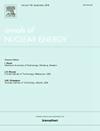Investigation of sodium compatibility of oxide ceramics for development of Advanced core Catcher for SFRs
IF 1.9
3区 工程技术
Q1 NUCLEAR SCIENCE & TECHNOLOGY
引用次数: 0
Abstract
Core Catcher (CC) is a passive safety device, provided in nuclear reactors for safe retention of core debris resulting from a hypothetical core melt accident. For Sodium cooled Fast Reactors (SFR), in-vessel CC is preferred for containing radioactivity within the reactor vessel. Design of CC for new generation of SFRs consider whole core retention. To protect the CC against corium impingement and limiting the temperature of structural members within safe limit, a refractory sacrificial lining is being developed. Among several requirements, long term compatibility of sacrifical materials with liquid sodium under normal operation as well as accident condition are essential. In the present work, alumina and Yttria Stabilized Zirconia (YSZ) have been investigated as candidate materials. Test specimens of alumina and YSZ were exposed to liquid sodium at various temperatures from 400 °C to 950 °C for time durations up to 10000 h. The exposed specimens were investigated for microstructural damage and chemical interaction with sodium. YSZ specimens were found to be intact for temperatures up to 950 °C for 24 h, whereas alumina specimens revealed surface cracking and loss of strength above 850 °C. Though, no detectable chemical interaction with sodium was noticed for alumina and zirconia specimens at 400 °C for a long-term exposure, formation of sodium aluminate and sodium zirconate was observed at higher temperatures.
YSZ specimens exhibited insignificant degradation at high temperature sodium exposure, while alumina resulted in severe microstructural degradation. Important findings are outlined in the paper.
求助全文
约1分钟内获得全文
求助全文
来源期刊

Annals of Nuclear Energy
工程技术-核科学技术
CiteScore
4.30
自引率
21.10%
发文量
632
审稿时长
7.3 months
期刊介绍:
Annals of Nuclear Energy provides an international medium for the communication of original research, ideas and developments in all areas of the field of nuclear energy science and technology. Its scope embraces nuclear fuel reserves, fuel cycles and cost, materials, processing, system and component technology (fission only), design and optimization, direct conversion of nuclear energy sources, environmental control, reactor physics, heat transfer and fluid dynamics, structural analysis, fuel management, future developments, nuclear fuel and safety, nuclear aerosol, neutron physics, computer technology (both software and hardware), risk assessment, radioactive waste disposal and reactor thermal hydraulics. Papers submitted to Annals need to demonstrate a clear link to nuclear power generation/nuclear engineering. Papers which deal with pure nuclear physics, pure health physics, imaging, or attenuation and shielding properties of concretes and various geological materials are not within the scope of the journal. Also, papers that deal with policy or economics are not within the scope of the journal.
 求助内容:
求助内容: 应助结果提醒方式:
应助结果提醒方式:


